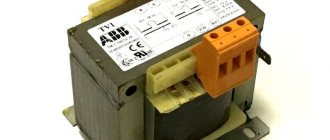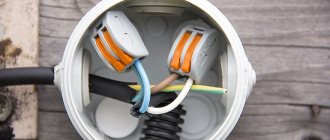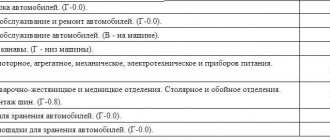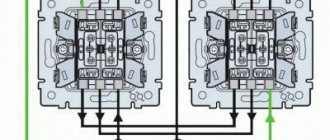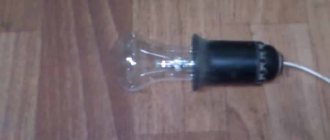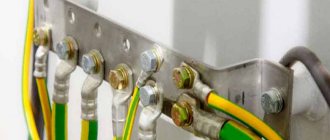Probes are an integral part of all multimeters, which comes complete with the measuring device, regardless of its model. Good probes have been performing their task well for many years. But it also happens that a few days after purchasing a multimeter, one or even both contacts fail due to a broken wire, broken tip or cracked insulation. To protect yourself from such a nuisance, you need to purchase high-quality and reliable multimeter probes, with good wires and durable tips. Many people prefer to make them themselves. In this material we will talk about the varieties and features of these elements, and also figure out how to make homemade probes for a multimeter.
Universal probes
These products are the simplest and cheapest. They are included with most inexpensive multimeter models. The cables of these elements are equipped with PVC insulation, and the plugs and lug holders are made of plastic. A thin wire is attached to the steel electrode from inside the holder. Such tips can easily come off if not handled carefully. It is clear that there is no need to talk about durability and high reliability here.
Different models of universal contacts have unequal lengths of the central electrode of the plug and the protruding part of its body. They also differ in the mounting depth of the plug.
Branded products
The multimeter can have a probe made of various materials. High-quality and reliable contacts can be distinguished by the following characteristics:
- Multimeter probe leads are made of highly flexible material.
- The holder insertion is flexible and sealed. The vein in it holds tightly and does not give in to random jerks.
- The surface of the product near the base of the holder does not slip and can be comfortably held with your fingers during measurements. The best option is a holder with a rubberized surface.
The video shows an example of such products:
Silicone probes have all of the above properties. These parameters are responsible for the high popularity of such products.
Often the holder inputs are made of plastic, but in this case they must have special recesses, otherwise the element will not have the required flexibility. On almost all branded models, plugs and electrodes are equipped with caps that protect the elements from contamination and minimize the possibility of puncture injuries.
These products were developed taking into account the experience of using earlier models, and therefore are distinguished by their thoughtfulness and ease of use. The wire of such contacts has sufficiently high strength and flexibility, is resistant to accidental jerks and does not crack when bent.
Probes for SMD mounting
When working with SMD elements, it is periodically necessary to carry out measurements, which can only be done using thin probes connected to the tester. These products are equipped with sharp brass or stainless steel needle-shaped tips. They are necessarily protected with caps, which minimize the risk of electrode fracture or accidental injury to the technician.
For SMD installation specialists, such elements are most convenient to use. With sharp probes you can not only pierce the wire insulation, but also scrape off the solder mask from the desired area of the board surface and then carry out measuring work. Although the thickness of this needle is very small, the element can easily withstand a voltage of 600 V for a long time.
For measuring work when installing SMD components, multimeter probes are also provided. They allow you to measure the required parameters of a part both on the desktop and directly on the board.
During the measurement, the component is clamped with pliers, which guarantees the quality of the contact. These products have a fairly short cable, but a long one is not needed to work with SMD.
If the measurement process requires maximum care to prevent the electrode from touching other parts, then it is best to use probes with holes at the ends.
With their help, you can take measurements both on printed circuit boards and during electrical installation work, without fear of accidentally causing a short circuit.
A SET of probes for a multimeter. Feeling the silicone™ - 4.
Working with a good tool is not only convenient, but also pleasant. Probes for the tester are, although a consumable, a very important consumable, and both comfort in work and, ultimately, the quality of this work depends on their quality. You may not agree, but my experience shows that probes should be: 1. high-quality 2. silicone 3. modular. If you think that probes should cost no more than two bucks, this review is not for you ;( So, I’ll start with the technical specifications, so to speak, or rather the agony of choice. I have probes, but at the moment there were only one modular and silicone probes. There are two testers , but the latter, although they are silicone, are not modular. And since the needles of the tips tend to wear out (and I am an auto electrician), modularity is needed without any options. With silicone, the situation is similar - I need the probes not to be afraid of either the cold or the hot exhaust manifold. Very often you have to connect wires over a long distance, so I would like the probes to be longer, and this is exactly what distinguishes the fluke probes - their length. Bratelnik used similar probes for his needs, and I really liked their long length. But there is a nuance - sometimes you have to call something from under the hood into the cabin, and here you need an asymmetrical wire so that the tester is at hand, and not somewhere in the middle. And I was already planning to buy such probes as from my brother, for them probes with straight connectors, and connectors. And then I saw this set, which turned out to be even cheaper, and it includes THREE pairs of probes (with straight and L-shaped connectors in all combinations), a pair of connectors and a bag.
I'll start from afar.
Connectors female-female 4mm. They are marked CE and CAT III 1000V CAT IV 600V. The plastic is not round, which theoretically prevents them from being visible on the table, for example. They are not magnetic. The probes fit tightly, you won’t be able to pull them out accidentally.
Now the actual probes. They are not afraid of a soldering iron, they do not tan in the cold. The connectors themselves are harder than wire, but also quite flexible. Inscriptions everywhere CAT III 1000V CAT IV 600V 10A. Well, FLUKE, which is not on either the connectors or the bag
The “bananas” themselves are something like this:
Here they are compared to the non-modular probes from my first review. The difference in length is impressive.
This is what they look like in the workplace:
This is what the tips from Bang look like on them (unfortunately they are out of stock, I’m looking forward to ordering others, we’ll see):
Now measurements. I think it’s clear how I labeled the probes? L is an angled connector, I is a straight connector.
In the process of writing the review, I doubted the readings of my home-made milliohmmeter and went and measured the resistance using the “old-fashioned” method, passing 1A current through the wire and measuring the voltage drop. It turned out 33/31/37 mV, which slightly differs from the milliohmmeter, but do not forget that the current there is much lower, plus I didn’t try too hard here
To sum it up: great kit. February 23 is ahead, if anyone has a smart auto electrician, for example, he will be very happy. For example, I bought it myself and am damn pleased. And if they gave it as a gift, he would probably jump up to the ceiling.
In principle, the price can be listed as a disadvantage. But almost any silicone probes cost about 7-10 bucks per set. And they are highly likely to be MAXIMUM 1.2m. Right there - as much as 1.6. Well, we have a good bag and a couple of adapters-connectors, which are also sold separately for 5 bucks.
But if 7-10 bucks for probes is too expensive for you, please don’t tell everyone about it. Everyone knows that there are probes of the same type - with a string of wire inside, with iron needles and PVC insulation. well, as in 830 testers, for example. These probes are for those who value quality, comfort and time. At the same time, they are relatively inexpensive and worth every penny, at least at first glance.
Crocodile tips
This version of the tip is also available on the modern market and is in considerable demand. In some cases, it turns out to be preferable to sharp electrodes. The size of the “crocodile” may vary, but in any case it must have a reliable shell made of dielectric material.
Connecting tips can be made in the shape of “crocodiles” and are used as an additional element for a standard probe. Often, the kit for the multimeter includes tips in the form of clip-on “crocodiles”, which, if necessary, can be either detached or attached.
It is also necessary to mention the kits, which include several different tips. When starting work, the master himself selects the one he needs and screws it in like an attachment. This feature allows in some cases to significantly simplify the measurement process. So, for example, a crocodile can be connected in turn to different sections of the electrical circuit being tested, while the other tip is attached to ground as a terminal.
Technicians who work with terminal components prefer terminals designed in the form of clips and hooks. With the help of such elements it is convenient to carry out measuring work on printed circuit boards, as well as to hold the terminal components in place during measurements. These tips, as well as needles and crocodiles, can be included in the delivery package.
Testing.
I don’t have a 20 Ampere load, and the 30 Ampere unit goes into protection when a short circuit occurs, so we will measure the wire resistance the old fashioned way.
The Aneng Q1 multimeter will act as a display meter. Even after inserting a bundle of thick copper wire into the connectors, I didn’t see zeros on the screen, but it was very close, so it definitely won’t show anything less than it is) First, I shorted the probes with medium needles, I got 0.12 Ohm Then thin needles, I expected the resistance to increase, but No, apparently the metal is different. 0.1 Ohm
“Crocodiles” took the lead - 0.09 Ohm
And then it dawned on me that you can connect the same cable to both connectors of the multimeter. Red 0.05 Ohm
Black is slightly better - 0.04 Ohm
The total is the same 0.09 Ohm that the “crocodiles” showed. This is the best result in my collection so far.
And it suddenly seemed to me that the insulation was still silicone, because... With the onset of cold weather, the wires did not double.
350 degrees proved that it seemed. It doesn't melt as quickly as normal, but it still melts.
Well, it looks like I didn’t forget anything about the set, let’s move on to the needles. Convenient for testing connectors without removing them. Here is the link to the store, they cost $2.3 I received a gray package
There is another bag in it
For SKU lovers
Silicone tips are good. Judging by the inscriptions, they can withstand up to 30 Volts, why not watts?
Diameter 0.5mm
Slightly shorter than the fine needle of the previous set
The wire is inserted into the connector with force and holds well
The handle is short, but needles are usually used where a lot of force is not needed. Due to the small cross-section (especially the tip), the resistance is also higher than that of conventional probes
Well, the third lot, which the hamster ordered while the toad turned away, just so it was. Here is the link to the store, price $6.62 Came in a black bag
Additionally wrapped in polyethylene foam
For SKU lovers
Written by Cat II 1000V
I thought they would be somewhat smaller. They sat quite tightly.
The operating principle is simple. The spring-loaded, hook-shaped needle is cocked with your finger.
A wire up to 4 mm is inserted under it, after which we release the mechanism, if necessary we help it pierce the insulation
I specifically took a defective multimeter cord - it has a lot of insulation and not enough wire.
Usually a puncture occurs without outside help, only due to spring pressure. And yes, the resistance is also somewhat higher compared to standard probes, because... The contact area is small.
I used them several times when testing car wiring in places where it was difficult to reach the nearest connection. You can also crochet exposed wires if the same “crocodiles” are far away. You can also pierce wires with needles, but these attachments are still more convenient and safer.
How to make homemade probes?
As we said above, many people prefer not to buy new ones when factory probes break down, but to make them themselves. Let's consider two popular options for making homemade products.
Standard homemade probes
To make them you will need dismountable fountain pens (without refills) and dart tips for darts.
The operating procedure is as follows:
- Disassemble the fountain pens and try on dart tips for them.
- Having selected the appropriately sized components, insert the dart tips into the handles instead of the rods, after heating them with a gas burner.
- Place a piece of solder inside the handle, after moistening it with soldering acid and heating it.
- Place the cable there.
- Wait until the solder cools down and the probe elements are fixed.
For additional fixation, the dart tip can be glued.
The entire device is clearly shown in the video:
Thin homemade probes for piercing insulation
Now let's figure out how to make thin probes for a multimeter with your own hands. To do this, we will need collet pencils using replaceable leads, and sewing needles of suitable thickness.
The production of thin probes is carried out as follows:
- Solder the cables to the needles.
- Insert the needles inside the pencils until they hit the center of the collet. To prevent them from going inward when pressed, they should be glued into the collet.
- Solder the plugs to the cables.
It is advisable to apply colored heat shrink to the resulting products. When working with a hair dryer, you need to be careful, as the flow of hot air can cause deformation of the plastic.
Pen and pencil caps can be used as protective elements.
The video shows an example of making needle probes for checking small parts:
Available silicone probes from Ali. Cheap, but is it cheap?
A quick overview of sharp, thin multimeter probes with silicone leads. In my search for affordable probes with silicone wires, I came across the cheapest ones (at the time of ordering I couldn’t find cheaper ones), at least silicone was stated both in the description and in the reviews. While trying to find out the wire parameters from the store, I suddenly received an offer to buy a sample, paying only $1 for delivery, and then provide feedback on the quality. The store didn't ask for a review, but I decided to share. Moreover, I received it with really silicone wires (the test and the lighter passed). That's it in a nutshell. And for photos, details and minuses found, please see cat. UPDATE:
Unfortunately, after the review was published, the seller raised the price to $4. But he regularly organizes promotions. After 8 days, the price is again low, as during the sale - $3.08.
A small retreat
Having broken the connector of the supplied PeakMeter probe, in addition to repairing it, I was puzzled by finding a second set with thin needles.
In general, I am not an “electronics engineer” in any way, and in everyday life I have enough of the simplest probes. But the convenience of a silicone wire in a soldering iron and a series of reviews by the respected uncle_sem, in the comments of which many copies were broken about silicone, prompted me to look for options with just such wires. Moreover, not having a professional need for expensive and high-quality probes, I looked for the most affordable options. So the store’s offer of a sample simply hit the spot. We can say that my review is a kind of antagonist to uncle_sem’s reviews under the motto “I want silicone cheap.” And a little about silicone from a layman’s point of view. In the process of searching, I pretty much tormented several Muskovites with questions.
2) Insulation made from “under-silicon”, let’s call it that, since the composition is unclear. These wires are flexible, they hold low temperatures well, remaining flexible, but they are afraid of a soldering iron. For example, there were some in this review.
3) Silicone insulation. Here are all the advantages of silicone - flexibility in the cold, they are not afraid of a soldering iron. There is a minus due to flexibility: because. Since probes and connectors are made of PVC plastic, the connection points, especially the entry points into the probe, can wear out, sometimes quite quickly. I'm judging by the reviews.
In addition, silicone wires come in two types - with a large number of very thin wires, more flexible, and also with thicker wires, the number of which is several times lower with the same cross-section, they are more rigid. I don’t know how to tell the difference. The second ones usually have full markings like VW-I SILICONE RUBBER 18AWG 200C 1000V. "But it is not exactly." This is a conclusion based on viewing a bunch of Ali lots with their parameters and reviews.
Stated characteristics
Materials:
silicone and gold-plated probe needle.
Length:
88 cm cable length (measured value 87 cm), total length 106 cm (measured value 107 cm).
Limits:
voltage up to 1000 V, current up to 20 A (probe marking CAT II 1000V 20A).
There is nothing to check the protection category and gold of the probe needle. But I seriously doubt that there is gilding here.
The parcel took 5 weeks to arrive by Latvian Post. The track was tracked, but with a small number of intermediate points.
By and large, there is not much to write about probes. First, let's see what the sent probes look like.
“Bananas” are cut, made from a single rod. I was pleased that they are inserted quite tightly into the multimeter, they turn in the socket with difficulty, which means the contact is good.
Of course, the most interesting thing about these probes is what kind of sheath the wires have. First, test in the freezer. According to the refrigerator, it is -18, once the value measured by a thermocouple was -16..-17. After 1 hour and 15 minutes in the freezer, the wires did not lose their flexibility, so this test can be considered passed. Below there is simply nothing to freeze. Of course, the probes and connectors themselves are made of PVC, so they hardened as expected. Ordinary probes in the same freezer turn into hard plastic; it’s even scary to unbend them.
Next is a test with a soldering iron.
The seller guaranteed only 200 degrees Celsius, so I started checking from the lowest limit that I have - 200 degrees (measured value 205). I apply it, move it back and forth across the shell. Not a trace. Further upward 250-300-350-400 degrees (measurements of the tip with a thermocouple). Likewise. I apply the soldering iron tip to the shell, then move it slightly left and right for a couple of seconds. At 400 I noticed a slight “swelling”, just like with the silicone mat, but it immediately returned to normal as soon as I removed the soldering iron. Well, I decided to check the pile with a lighter. The flame temperature in the lower part is about 600-650 according to the thermocouple. But running a lighter along a wire does not leave any marks. Just a little soot if you linger a little and move it through the middle of the flame. A small comment.
I'm not sure that the lighter test is indicative. After I recorded the video, I tried a similar action on twisted-pair wiring in polyethylene insulation. Several passes with a lighter and they left no marks on it. To start melting, even burning, you need to hold it for 2-3 seconds without a break. But a regular PVC-insulated wire does not pass the soldering iron test accurately.
Another interesting parameter is resistance. On my instruments there are zeros (although, for example, for the supplied PeakMeter MS8236 probes it outputs 0.2-0.1 Ohm). I took the opportunity to measure at work using a more accurate device. The LCR meter showed a value of 80 mOhm for two probes. Indirect test by voltage drop: at a current of 5 A from a laboratory power supply, the voltage on one probe is approximately 185 mV, which corresponds to 37 mOhm at the probe. So the readings can be considered reliable; at least they reflect a qualitative characteristic.
The diameter of the core for clearance is around one millimeter. So we can assume a wire size of 18-20 AWG. This roughly corresponds to the obtained resistance value. A current of 5 A had no effect on the wire. I did not feel any heating when checking with a voltage drop; the current exposure lasted about 30-40 seconds.
Flaws
Naturally, the probes are not perfect.
Below I will list the points that I did not like. 1. “Noname” wire, without any markings at all. There are a couple of places where the shell is slightly uneven, to the point of nitpicking. I don’t know if the same wires are always used when making probes.
2. The wire is not fixed in the connector and in the probe. When bending, a gap is visible. Most likely, this is a consequence of the use of silicone; PVC does not fuse with the wire sheath during manufacturing. Theoretically, this increases the stress on the wire solder joint if the wire is accidentally pulled. But the gap is very small, so this is also more of a nitpick. It’s a little annoying to think that the wire slightly rubs against the PVC material of the probe during operation. And at the point where the probe enters, the wire can actually be damaged. There are such reviews about similar probes (for example, a fairly popular lot of similar probes with a photo with a lighter, which cost $4-$5).
3. The “tail” of the probes is not flexible. Ordinary, standard inexpensive probes. It would be much better if the wire input was designed in the form of a more flexible cuff, like the included Holdpeak probes:
Conclusions.
For their price, I consider the probes worthy of attention.
At least when choosing from budget ones. I think the disadvantage is that the stated parameters of the wire are up to 200 degrees Celsius, so it’s not a fact that in other batches the probes won’t have a different shell (that same “under-silicon”). But the reviews are positive so far. The workmanship is the usual standard inexpensive probes. Those. These are the same probes for $1-$2, only with silicone wire. I perceive these probes either as an option for a budget consumable for work, or as an option for a budget-conscious home craftsman.
PS: I did the review a little in a hurry, because... I had to postpone writing due to personal problems. But taking into account the fact that this product is also included in the sale, which began today, I decided to have time to write it, albeit in a crumpled form.
The product was provided for writing a review by the store. The review was published in accordance with clause 18 of the Site Rules.
